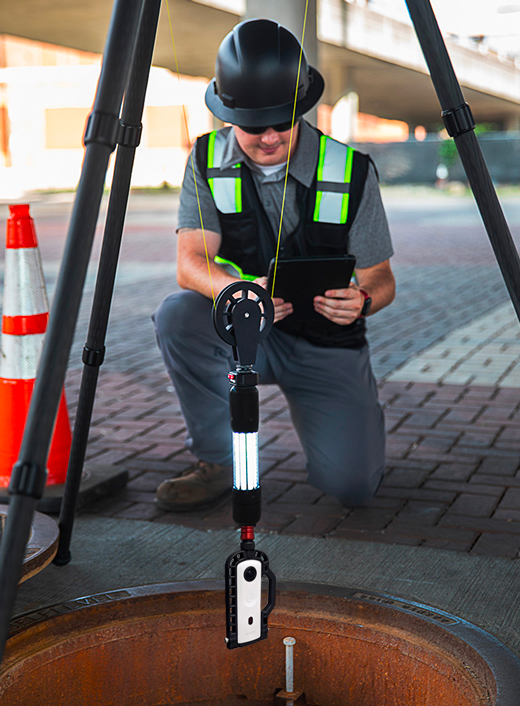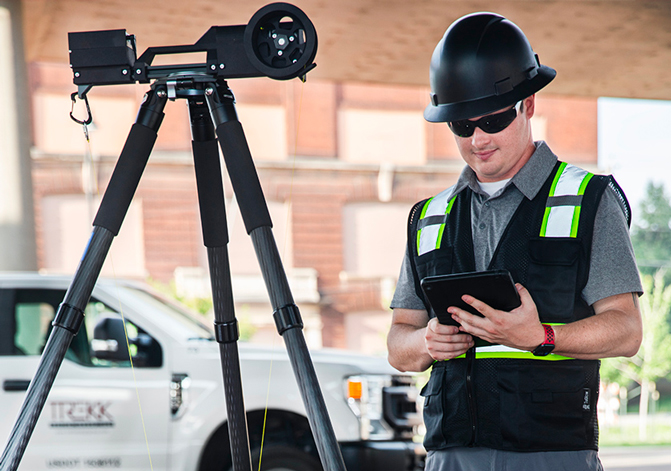Built to Last
The TREKK360 Camera was specifically designed for our field crews to safely and efficiently inspect manholes without confined space entry. Tested by our technicians in tens of thousands of manholes, it has proven to be a reliable, robust and easy to use solution.
With the TREKK360, you can trust that you’re using the best manhole inspection camera kit available.

FAQ
Which camera model do you include in your kits?
The Insta360 X4 ships standard with the TREKK360. The Ricoh Theta SC2 is also available.
Is your system waterproof?
Yes. The Insta360 X4 camera is rated waterproof to 33ft (10m).
Do I need to contract with TREKK for processing panoramic viewers and 3D models?
Not at all. Many of our customers use their preferred software or third-party services with the images captured by the TREKK360. However, we do offer professional processing and creation of Panoramic Viewers and 3D Models, handled by our team of highly skilled technicians.
Can TREKK360 generate point clouds as accurate as LIDAR?
This camera system uses photogrammetry for deriving 3D models and point clouds, which is not the same as LiDAR-derived point clouds. Unlike cameras, LiDAR uses lasers to measure distance, which offers an even tighter accuracy of measurement in a very dense scan. While TREKK360 and photogrammetry can derive “point clouds” from photogrammetry, these are not of the same degree of accuracy as a truly LiDAR-derived scan, and should not be relied upon for survey tolerances. We tend to see 1% to 2% of error over the total length of photogrammetry-derived measurements, which is a broader tolerance than the mere millimeters of error derived by LiDAR. However, for a majority of applications in Sanitary and Stormwater inspections, photogrammetry offers an acceptable measurement standard that is more practical to deploy across masses of structural inspections.
Do you offer virtual inspection services for any scans uploaded by TREKK360?
Yes! Our project engineers and data technicians have performed thousands of virtual inspections and can offer a custom quote for your needs. Feel free to reach out to us to start the dialogue!
What kind of batteries are needed for a TREKK360 kit?
We designed this system to be as versatile as possible, so standard rechargeable 18650 batteries are used to power the lights, and a drop-in rechargeable battery pack powers the motorized lowering rig. All batteries are supplied with each kit, and more can be purchased at online retailers.
Do you offer on-site training and support services for field staff?
Yes, we can arrange for this, and even virtual/phone call support too. Custom quotes for ongoing support services can be made upon request, at any time.
What kind of warranties or repair options do you offer with the purchase of a TREKK360 kit?
We offer a standard 1-year warranty from the date of purchase, covering defects in operational parts and workmanship. This includes the camera, provided it is used under normal operating conditions and not due to accident or neglect. Any defects that were incurred as a result of improper exposure to water or chemicals, shock, impact, or improper storage will not be covered in this warranty. For parts covered within warranty, simply return to us with purchase verification and we will refurbish or issue a replacement. For all other repairs outside of warranty, individual component replacements will be quoted as needed.

Contact Us
TREKK Design Group, LLC
1411 East 104th Street
Kansas City, MO 64131
Phone: (816) 313-8539
www.trekkllc.com

